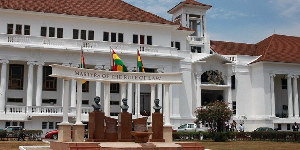Train up a child in the way to go, and when old, s/he will not depart from it, says Proverbs 22:6. This statement basically implies education is the key to prosperity and personal development. However, the type and the method of education critically matters. While the preceding statement is true, it is necessary that we ponder over Prov. 22:6 regularly. That, I suggest will drive us to determine what legacies to leave for the next generation. After all, some legacies were passed onto us - good and/or bad. And it is essential that we pass onto next generation better legacies than we inherited. I believe this calls for sacrifice and some deep thoughts as well as promotion of warm heartedness. By this Ghana will be more prosperous, safer, focused and have a solid foundation for development.
Since education is the key, it will be prominent for most high school graduates to have some access to higher or university level education irrespective of the location. Opponents may argue that the idea is counter-intuitive because unemployment is already soaring and there are no jobs for the existing graduates. Therefore, implementation of such an idea will be tantamount to adding pepper to the existing wounds. Additionally, it will lead to abundance and watered-down degrees. Moreover, it may strain the government’s budget since that will call for increased educational budget since the already existing is dwindling. The question is, how accessible are the existing ones to the various communities? Is the existing ones serving as it should? Has a proper assessment been done to determine if all communities can have some level of access to advanced or higher education, in the first place, and what are the payback to Ghana?
To highlight the idea that I am proposing, let look at a 2010 Wikipedia information below, showing the distribution of the number of professional institutions and universities (PIU) across Ghana (http://en.wikipedia.org/wiki/List_of_universities_in_Ghana), the land size and pollution distribution by regions (http://en.wikipedia.org/wiki/Regions_of_Ghana). This information may not be very different today 2015 if one exist. Here the ratio of the number of professional institutions and universities (PIU) to population density will be used as a simple quantitative measure of higher educational accessibility across Ghana. Though, other factors including proximity, access roads, size of professional institutions and universities, nature of programs and number of bordering regions are necessary, it will partially be used for the assessment. In addition, each region will be treated as a separate entity.
• Ashanti: population - 4,780,380, land size - 24,889 km2; population density - 192/km2, has 12 professional institutions and universities (PIU), and calculated PIU to population density ratio of 0.063.
• Brong Ahafo: population - 2,310,983, land size - 39,557 km2, population density –58/km2, has 4 professional institutions and universities (PIU), and calculated PIU to population density ratio of 0.069.
• Greater Accra: population- 4,010,054, land size - 3,245 km2, population density–1236/km2, has 60 professional institutions and universities (PIU), and calculated PIU to population density ratio of 0.049.
• Central: population- 2, 376,021; land size -9,826 km2, population density –242/ km2, has 4 professional institutions and universities (PIU), and calculated PIU to population density ratio of 0.017.
• Eastern: population- 2,633,154, land size -19,323 km2, population density –136/ km2, has 7 professional institutions and universities (PIU), and calculated PIU to population density ratio of 0.052.
• Northern: population- 2,479,461, land size -70,384 km2, population density – 35/km2, has 2 professional institutions and universities (PIU), and calculated PIU to population density ratio of 0.057.
• Western: population - 2,376,021, land size -23,921km2, population density – 99/km2, has 1 professional institutions and universities (PIU), and calculated PIU to population density ratio of 0.010.
• Upper East: population- 1,046,545, land size -8,842 km2, population density – 118/km2, has no professional institutions and universities (PIU), and calculated PIU to population density ratio of 0.000.
• Upper West: population - 702,110, land size -18,476 km2, population density – 38/km2, has no professional institutions and universities (PIU), and calculated PIU to population density ratio of 0.000.
• Volta: population - 2,118,252, land size -20,570 km2, population density – 103/km2, has 2 professional institutions and universities (PIU), and calculated PIU to population density ratio of 0.019.
The higher the calculated PIU to population density ratio the better the higher educational accessibility. Though, the above population distribution does not indicate the percentage of high school students, one can still use the information to draw some conclusions because there is no age limit on schooling. In addition, there is no information on access roads, means of transportation, or distances involved. Moreover, the universities are not the same size, and does not have the same programs or specialized courses to meet the various communities’ needs.
Based on the ratio of PIU to population density the higher educational accessibility decreases in the order from Brong Ahafo (0.069), Ashanti (0.063), Northern (0.057), Eastern (0.052) Greater Accra (0.049), Volta (0.019), Central (0.017), Western (0.010), Upper West (0.000), to Upper East (0.000) regions.
Using the Greater Accra Region ratio of 0.049 as a reference, Ghana is divided into about two (2) halves i.e. regions not lacking access and lacking access. Regions not lacking PIU access in descending order are Brong Ahafo (0.069), Ashanti (0.063), Northern (0.057), Eastern (0.052) and the Greater Accra (0.049). And regions lacking access in descending order are Volta (0.019), Central (0.017), Western (0.010), Upper West (0.000), and Upper East (0.000) regions.
One striking observation is Western (0.010) which locates the 3rd largest city in Ghana struggling for PIU or higher education. What will happen to the inhabitants of such a region with significant high tech jobs and produces some of the nation’s key resources but have very low higher educational accessibility? The information reveals a huge PIU educational deficit to match the region’s high tech jobs? Are key positions gradually taken over by very educated Ghanaians from other regions of Ghana? Is the inhabitant not interested in PIU education to match some of the high tech jobs? Or is Western being neglected? Is the low PIU access gradually taking away key positions? Is this PIU deficit slowly pushing the inhabitants of this area to the background always to welcome new key people from elsewhere to the region? What is happening to Western Region? What plan is in place to close up the number of PIU gap to better serve the people of the Western Region? The weak higher educational accessibility for Western is not a good sign for the regions development and something needs to be done. Is UMat going to increase capacity and add more programs to bridge the Western PIU? Is UMat alone well located to serve the whole region? What about Takoradi Polytechnics converted into a University, and high schools such as GSTS, Sefwi Wiawso Senior High Secondary, St Augustine Senior High School- Bogosu, Nkroful Agricultural Secondary School (NASS), etc. hosting long distance PIU education?
Another is Central (0.017) with all the renowned high schools also lacking PIU education for the high school graduates to further their education. The question is, is greater portion of the Central high school students actually from Central? If not where are the natives educated sufficiently to take up the challenges of the land? Is the gradual degradation of Cape Coast an indication that greater portion of the indigenous are not having the chance to further their education to take up challenges of the land?
Volta (0.019) is lacking PIU as a region, however, the shape of the region presents proximity to regions such as Greater Accra, Eastern, Brong Ahafo and Northern which makes this region accessible to a total of about 73 PIU i.e. 60, 7, 4 and 2, respectively. This proximity may explain why the Voltaians are among the very well educated. However, this should not be an excuse for Volta not to close up on the number of PIU gaps as well as have PIU with programs tailored to meet the needs of the communities to reduce rural-urban migration.
Both, the Upper East and Upper West are on the upper end of Ghana bordering Burkina Faso and have no universities. The only available universities are the two (2) in the Northern Region if only it is very accessible, have the right programs, sufficient capacity and facilities to absorb Upper East and West Regions. Both Upper West and East definitely need professional institutions and universities (PIU).
The question becomes, how do areas lacking professional institutions and universities (PIU) close up the gap to limit congestions and migration in some bigger cities? What are the benefits of closing up PIU numbers in the various regions and communities that lacks them? Will the close up not foster interactions of the various tribes and regions? What are the pros and cons? What are the strategies to adopt to ramp up PIU education to enhance talents and not to waste them? Will the government be able to handle this given the dwindling educational resources and budget while this idea requires an increase and close attention? How is education viewed in our part of the world? What value do we place on education? Do we think India, China, Singapore, Malaysia, etc. who were not far from Ghana in economic strength not long ago got to where they are today without the pursuit of education? How far can Ghana as well as Africa as a whole see? Is our stomachs more important than our brains? Does our stomach control our brain? Why the lags and lacks?
Well, in my view some high schools are strategically located and have campuses that can be used for long distance higher education with some of the major universities or start a university education to better serve the area. Moreover, there are numerous abandoned government buildings that could be renovated to start some university education. Today, there are numerous advanced degrees holders as well as retirees with extensive life experiences in Ghana to tap into for the different education programs. Why do we let these knowledge rot while there are serious needs for the new generation? Interestingly, air transport and some of the improving road conditions are adding more blessing to connect Ghana to save time. I know the education part of the national pie on government budget will increase, however, this is for a good course with a huge near future benefits if strategically planned. Some of the several benefits of the idea to the nation includes;
• Lowering rural-urban migration, lowering overcrowding in some cities such as Accra which is a nightmare by the way of our operations.
• Lowering the talents wastage from our current educational system
• Lower the burden on our roads, lowering traffic, and lowering road accident
• Communities will be self-sufficient to prevent over reliance on government
• Serving all communities with some level of professional institutions and universities (PIU) education to empower them
• Opportunity to tailor professional institutions and universities (PIU) programs for special students and communities needs to better the area which is not available on the main stream education thereby empowering them to invest in what they are known.
• Teachers having opportunities to recalibrate and advance their education anywhere in Ghana while having the opportunity to give back to the communities.
• High school campuses housing professional institutions and universities (PIU) programs preparing high school graduates sufficiently for PIU education because of available highly educational personnel onsite.
• Needy but intelligent student will have some opportunity to continue with PIU education with little travel.
• Saving cost and improving on the current states of some high schools education.
• Candidate high schools having some source of money not to overly rely on the government and some of the bureaucracies
• Schools having some flexible opportunity to dynamically engage good students who did not get opportunity to enroll in some of the existing major PIU because of money and given the keenness of some university entry requirements.
• Providing educational continuity for needy but good students.
• Enhancing and strengthen communities for what they are best known for while providing the necessary manpower to better serve and support the area.
Given the current educational distribution, the question is, should every Ghanaian move to Accra and Kumasi for PIU education given the number of professional institutions and universities (PIU) as well as flexibility of the programs to choose from? Will students after graduation in the city move back to help their communities once they have tasted city life? Can the infrastructure in Accra and Kumasi handle the population influx it has created for itself? What is being done to slow this migration? What is being done to secure the rural areas to support the urban areas?
I humbly request the government, various bodies including Alumni and individuals, to put in a stake to strengthen Ghana’s higher educational length and breadth. I know it is easier said than done, however, Ghana is relatively small to be limited for not doing anything. I believe planning, dedication, selflessness, generosity, penchant to leave a legacy, thought of the future generation, honesty and others we will achieve. This should not wait till population soars. A good structure or foundation in place will go a long way.
It is time to be dynamic and beware that the current capitalist system on a socialist platform have many drawbacks that hinders progress by its inefficiencies, bureaucracies, partisan, no performance monitoring, etc. Hence, instituting good policies and procedures to activate the system while Ghana’s population is still small is prominent. I believe tailoring the education to incorporate the needs of the various communities, as well as the current and future needs of Ghana will be helpful to meet the growing Ghana’s demands. Education is key, however, the type of education is important for a firm nation building. Let us make the world a better place by making good education accessible to all.
Remember the seeds sowed yesterday is what we are reaping today. Today’s sowing is for tomorrow’s reaping. Let go beyond tribal differences, politics, etc. and sow good seeds today to better the future and the legacies we owe the next generation.
God bless
Alexander Anim-Mensah, PhD (ChE)
Dayton Ohio
alexraymonda@yahoo.com
Opinions of Tuesday, 2 June 2015
Columnist: Anim-Mensah, Alexander














